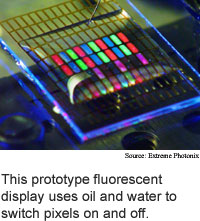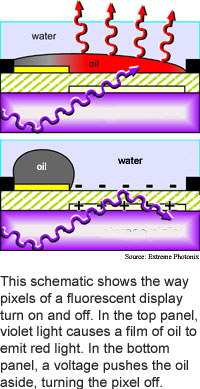
Oil and water drive display
Researchers from Extreme Photonix and the
University of Cincinnati have combined water and oil in a technology that
promises bright, energy-efficient displays.
The researchers' prototype is a combination of the researchers'
previously developed lightwave coupling technology, which channels violet
light from within a sheet of plastic or pane of glass to individual pixels,
and an electrowetting device that turns each pixel on and off.
The electrowetting device contains water and oil that compete
for placement on a surface. The surface is hydrophobic, or water repellent,
which leaves the oil covering the surface. This is the pixels' "on" state.
Applying a voltage to the surface attracts the water, which displaces
the oil to turn the pixel off. The pixel can switch on or off in ten thousandths
of a second, which is fast enough for video.
The oil film contains lumophores, or organic molecules, that emit
red, green and blue light when they absorb violet light provided by light-emitting
diodes.
The method could be used in signs, to make bright energy-efficient
displays in cell phones, handheld computers and laptops, and eventually
in screens designed to provide a lower-cost alternative to high-definition
television.
The researchers method could be used in signs within two years.
The method could be used in practical computer displays in five to ten
years, according to the researchers. The work appeared in the January
3, 2005 issue of Applied Physics Letters.
Nano bridge builds logic
Braille display drives biochip
Adaptive lights organize traffic
Nanotechnology: the physics of the very small
Briefs:
Spray-on photocells harvest infrared
Oil and water drive display
Chemical fuse makes cheap sensors
Metals speed transparent circuits
Plastic records infrared light
Magnetic logic becomes practical
Plastic memory retains data


Research Watch blog
View from the High Ground Q&A
How It Works
RSS Feeds:
News
Ad links:
Buy an ad link
Ad links: Clear History
Buy an ad link
|
TRN
Newswire and Headline Feeds for Web sites
|
© Copyright Technology Research News, LLC 2000-2010. All rights reserved.